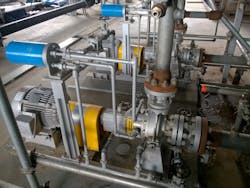Unfortunately, many mistakes and problems are often repeated in the design and operation of industrial wastewater treatment plants. As a result, many have been unable to meet required treated water quality standards and were subjected to extensive and costly modifications. Some were even demolished. Lessons learned and some key data related to design, engineering, operation, reliability and renovation of industrial wastewater treatment units are discussed in this article.
Industrial Wastewater
Industrial wastewater can be a major source of environmental pollution. Proper treatment is necessary for any type of industrial wastewater before reuse, re-application (such as irrigation, agriculture, etc.) or discharge to the environment. Many industrial plants discharge wastewater with significant levels of metals and impurities such as lead, mercury, cadmium and chromium, toxic materials (arsenic, selenium, etc.), nitrogen compounds (nitrates and nitrites), solids, debris, various organic and inorganic matters, oils, petroleum products, lubricants, chemicals and others. Nowadays, air pollution controls such as wet scrubbers have been extensively used in various plants and facilities. These can transfer the captured pollutants to the wastewater stream, which should be properly treated.
Municipal vs. Industrial Wastewater
Municipal wastewater treatment and industrial wastewater treatment are not the same. Compared to municipal wastewater, industrial wastewater contains different pollutants and is often more variable, concentrated and toxic. The nature of the design, procurement, construction, operation and economics are also different. Unfortunately, many industrial treatment systems are still analyzed, designed, procured and operated like municipal systems. Industrial wastewater conveys many toxic and hazard materials and there are governmental, local and international standards imposed on these industrial wastewater streams and their discharge limits. This complicates the treatment of industrial wastewater, making these facilities far more complicated than urban/municipal wastewater treatment units. These plants are more comparable to process plants than to municipal wastewater treatment plants.
There are critical points differentiating the sophisticated and complex nature of industrial wastewater treatment facilities from conventional sewage treatment plants. In fact, there have been many industrial wastewater treatment plants that were built based on copying domestic/municipal sewage plants. Subsequently, many had to undergo expensive and vast modifications to achieve some satisfactory operation. Some of them were demolished.
Risks for Industrial Wastewater Treatment Plants
Industrial wastewater treatment plants are complex. There is always the risk that a treatment plant cannot operate as expected and treated wastewater at discharge does not meet the required limits. This is often known as “risk of unsatisfactory operation” or “insufficiency.” Another major risk is overall plant costs being much higher than expected by the owner/operator. This is practically applicable to initial plant cost, operational cost or both — although the focus has usually been on the initial cost (capital cost). Operational costs, particularly energy efficiency, cost of materials (such as chemicals) and others (number of operators, maintenance costs, etc.), should also be considered.
Regarding two major risks — unsatisfactory operation and high cost — there can be a link between the two. If the treated water cannot meet the specified limits, then modifications and corrections might be needed that can result in cost blow-out. Sometimes vast changes might be needed; this can be a disaster in terms of cost and time.
Some adopted technologies and processes come with a level of hazard, such as working with chemicals. These need proper risk assessment and mitigation on a case-by-case basis.
Pollutants & Discharge Limits
Two important considerations for design and/or verification exercises have been the pollutants in the incoming wastewater and the allowable discharge limits of the treated water. These deserve great attention. However, there are other important data and information that should be considered. For instance, analysis of historical data of wastewater from industries, studies of sample analysis of wastewater from the industries, and reference to published data of similar industries are also important. Treatment plants that receive multiple wastewater streams from different industries need particular care.
Stringent Limits vs. Optimum Design
Unfortunately, there have been many cases of designs with a sole focus on stringent discharge limits (more stringent than specified standards) to determine the plant’s parameters. Too often the situation is like this: a team of engineers selects a set of limits from a standard and applies some ample safety factors and margins to reach the new stringent limits. These so-called new, tight limits then become the basis of design for the treatment facility with the promise to achieve a plant that can significantly exceed standards. The problem is that, to achieve such a conservative set of limits, new treatment units and new equipment with considerably high capital/operational costs and sometimes with more risks must be included. This can impact the overall costs, performance, operation and even commercial viability of the plant. While optimization is always important, often there is no need to consider overly conservative margins on well-established international or local standards.
Varying composition of wastewater from different industries should be considered as this usually results in dilution of contamination. This can lead to a realistic and optimum arrangement and settings. Analysis of both historical and current wastewater data should also be considered. This is valuable information for the design, verification, commissioning and operation of a treatment plant
Operational Flexibility & Occasional Spikes
A properly sized equalization system (most often in the form of an equalization tank) and slightly larger than required biotreatment system (particularly tanks, storage units and basins) are always encouraged for dealing with peaks in flow and pollutants. There might be occasional spikes in pollutants primarily due to some process destabilization, unexpected leakages, start-up or shutdown of some facilities, and other transient cases in wastewater-producing industries. Such spikes can be dampened in the equalization tank and the large biotreatment basins.
Another option for dealing with peaks in flow and concentrations is emergency storage such as emergency tanks and emergency lagoons. Such an emergency storage system would be feasible if the peak is short term (1 or 2 days). If emergency storage is available, then the flow should be diverted and then fed into the system in measured proportions when normalcy is restored in the incoming wastewater.
In case of a sustained spike, sophisticated treatment units such as a Fenton’s stage could be brought into operation for the duration. Hence maintaining a critical stock of chemicals in the proposed storage area is essential. This means several days or even a week's worth, depending on a proper risk assessment. The start-up and stabilization of such a treatment process should not consume much time as this is a direct chemical reaction and the dosages can be calculated by the operations team.
Online Monitoring
A lesson learned in previous treatment plants is that a capable and thorough online monitoring system is a great help for operation and troubleshooting. Online monitoring of wastewater through the treatment system is a modern requirement for today’s plants. In other words, key characteristics of treated wastewater should be monitored in key locations throughout the treatment process to evaluate the operation of each treatment unit and evaluate the overall performance of the plant. Monitoring data are also useful to spot developing problems and impending failures. This is a good investment for any treatment plant.
Capital Cost & Operation Cost
There are two important costs associated with wastewater treatment: the first is capital cost and the second is the overall operation and maintenance cost. This is usually expressed as the cost of treatment per cubic meter of wastewater. While it typically comprises many items, the main parts of operational cost are the manpower cost, the cost of energy and the cost of chemicals. There have been some special treatment units, such as a Fenton process, with complex facilities and a high cost of operation due to many factors, such as the high cost of large volumes of chemical consumed. These units can increase the cost of treatment per cubic meter of wastewater to 150–200 percent of the original estimates. The inclusion of such complex and expensive units should be carefully analyzed.
Capital Expenditures
Capital expenditures drastically increase if more polluted industrial wastewater is expected or more stringent standards for the treated water must be met. As a rough indication, for large industrial wastewater treatment plants, capital expenditure can be somewhere between $20,000 and $40,000 USD per cubic meter per hour (m3/h). Further, an average figure of $25,000/m3/h might be used as a first guess for an ordinary plant. The upper limit, say $40,000–$45,000/m3/h, is applicable for relatively more polluted wastewater and stringent discharge limits. The lower limit, say $15,000–$20,000/m3/h, is applicable for simple facilities. For example, the capital cost of an industrial wastewater treatment plant of 4,000 m3/h capacity might be estimated around $100 million (as a very rough estimate).
Operating Costs
Power consumption in the plant will increase with the increase in pollutants in incoming wastewater, but the impact on the unit cost per m3 of water treatment is usually marginal. Manpower costs are related to the number and skill level of operators; these are not usually related to pollutant concentration of incoming wastewater or tightness of discharge limits.
Often, only the costs for chemicals are related to pollutants in incoming wastewater and discharge limits. As an indication, the cost of chemicals would be roughly $3.00/m3 for a treatment plant with medium complexity . For simple plants (such as those without a Fenton process), this cost is around $1.00/m3. For very complex plants (which use different chemical-intensive units to treat highly polluted wastewater), this cost might be as much as $5.00/m3.
The increase in chemical cost with plant complexity and tight limits is obvious. For the abovementioned industrial wastewater treatment plant of 4,000 m3/h capacity, the cost of chemicals would be $150,000 to $250,000 per day. A major factor is the use of special treatment facilities such as a Fenton section, which requires massive volumes of chemicals. The chemical costs for such unit(s) would be high.
Upgrading & Renovation of Treatment Plants
There are many reasons to upgrade or renovate treatment plants. For instance, there may be revisions of codes and standards which mandate tighter limits for treated wastewater. New units and stages should be cost effective, compact and easy to install.
Available space is nearly always limited in renovation projects. Therefore, large tanks, basins or conventional treatment units (such as clarifiers) are not usually suitable for upgrading, renovation and modifications. Compact filter units, membrane treatment stages, packaged treatment units, or similar are recommended for these cases.
Most options available for upgrade and renovation of industrial wastewater treatment utilize filtration processes for treatment, including some membrane treatment options. Membrane treatment technologies have become increasingly popular, although they have their limitations due to cost and other factors. Nonetheless, they may offer advantages over more traditional treatment options in the right applications. WT

